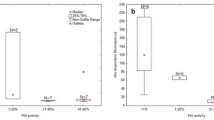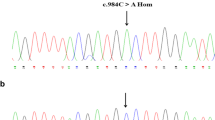Abstract
A defect in the factor XIII gene can result in lifelong bleeding tendency. In 3 Chinese families, hereditary coagulation factor XIII deficiency was diagnosed on the basis of the clinical syndrome and solubility of fibrin clot in 5 mol/L urea. We sequenced all of the FXIIIA gene exons and the flanking region and found 3 novel defects in the factor XIII gene. First, C →G transition at nucleotide (nt) position 1241 in exon 10 results in substitution of Ser413 with Trp. Second, C →T transition at nt232 in exon 3 results in Arg 77 →Cys. The third mutation is in exon 5: del-aa at nt598 (codon 191) causes frameshift and premature termination. In the cytoplasm of 3 probands the FXIII gene was normal at the messenger RNA level. Three mutations may affect FXIIIA protein conformation or incorrect protein folding and lead to formation of mutant FXIII that is very unstable and rapidly degraded in cytoplasm.Int J Hematol. 2003;78:251-255.
Similar content being viewed by others
References
Koseki S, Souri M, Koga S, et al. Truncated mutant B subunit for factor XIII causes its deficiency due to impaired intracellular transportation.Blood. 2001;97:2667–2672.
Slaughter TF, Achyuthan KE, Lai TS, Greenberg CS. A microtiter plate transglutaminase assay utilizing 5-(biotinamido)pentylamine as substrate.Anal Biochem. 1992;205:166–171.
Song YC, Sheng D, Taubenfeld SM, Matsueda GR. A microtiter assay for factor XIII using fibrinogen and biotinylcadaverine as substrates.Anal Biochem. 1994;223:88–92.
Miloszewski KJA. Factor XIII deficiency.Br J Haematol. 1999;107:468–484.
Ichinose A, Tsukamoto H, Izumi T, et al. Arg260-Cys mutation in severe factor XIII deficiency: conformational change of the A subunit is predicted by molecular modelling and mechanics.Br J Haematol. 1998;101:264–272.
Takahashi N, Tsukamoto H, Umeyama H, et al. Molecular mechanisms of type II factor XIII deficiency: novel Gly562-Arg mutation and C-terminal truncation of the A subunit cause factor XIII deficiency as characterized in a mammalian expression system.Blood. 1998;91:2830–2838.
Vivien CY, Lars CP, Isolde LT, et al. Three-dimensional structure of a transglutaminase: human blood coagulation factor XIII.Proc Natl Acad Sci USA. 1994;91:7296–7300.
Niiya T, Osawa H, Bando S, et al. A complete deficiency of coagulation factor XIII A-subunit due to a novel compound heterozygote of Ser 413 Leu missense and an nt 389 (ins G) frameshift mutation.Br J Haematol. 1999;107:772–775.
Author information
Authors and Affiliations
About this article
Cite this article
Duan, B., Wang, X., Chu, H. et al. Deficiency of Factor XIII Gene in Chinese: 3 Novel Mutations. Int J Hematol 78, 251–255 (2003). https://doi.org/10.1007/BF02983803
Received:
Revised:
Accepted:
Published:
Issue Date:
DOI: https://doi.org/10.1007/BF02983803




